Introduction
While I have been enjoying my experiences and time playing cosy games for the last year or so, I have come to realise that cosiness, funny as it may sound, is a double-edged thing. It soothes, it softens, but it can also smother. Developed by Pine Creek Games, Winter Burrow is, without a doubt, one of the most charming games I have played this year, and definitely the cosiest survival game. Yet comfort without contrast begins to lose its flavour. While I appreciate that Winter Burrow is not trying to be “red in tooth and claw,” by the end of my eight-hour playthrough, it felt rather toothless.
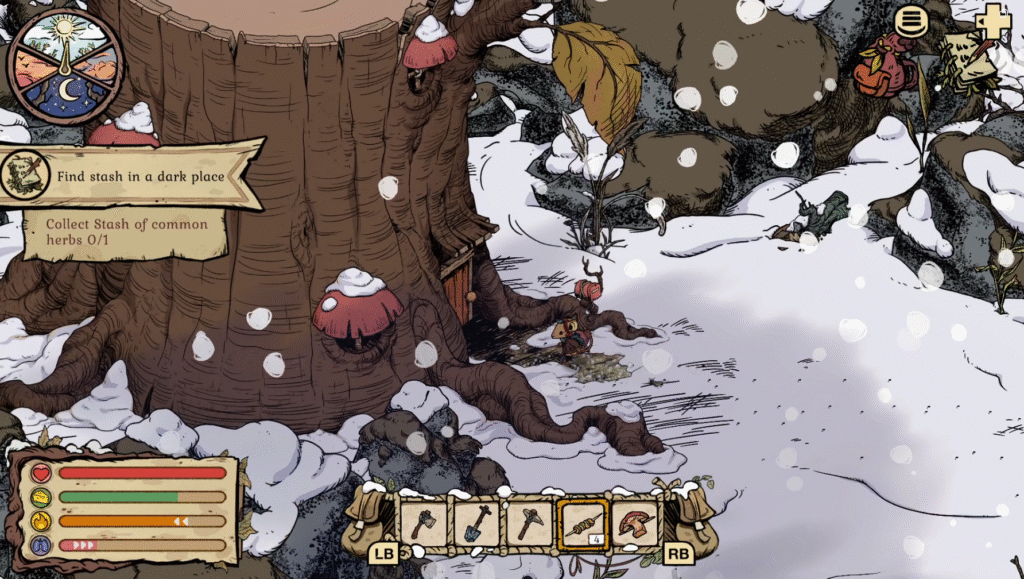
Premise
In Winter Burrow, you play as a young mouse who has returned from the bustling city to your childhood burrow in the woods, only to find it in complete disrepair and your Aunty Betulina nowhere to be seen. After quickly making yourself a bed to sleep in and getting a fire crackling in the stove, you are ready to set off into the snow-laden forest to explore and find your Aunty. Your reunion is sweet but short-lived, as she is snatched up and whisked away by a huge owl, and only you can save her!
What follows is a narrative-driven survival crafting game where you will collect resources, craft new gear to protect you from the cold, cook food to keep your belly full, and build furniture to furnish your burrow, all while helping some of the other inhabitants of the forest on your quest to rescue your Aunty.
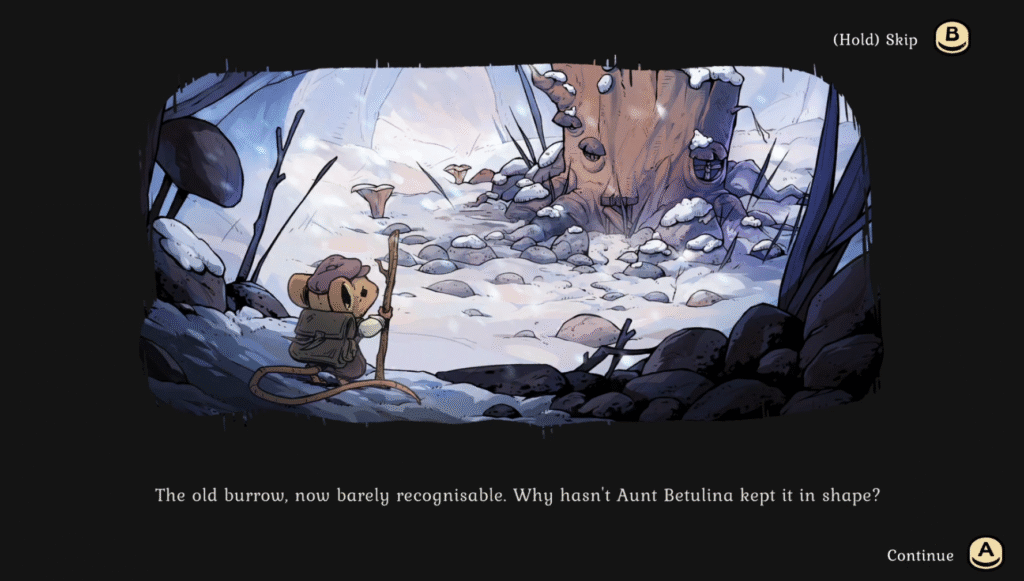
I really like Winter Burrow’s premise and opening moments for the most part, as it feels like the natural jumping off point for both a cosy game about cute woodland critters wearing scarves and drinking tea, and a survival game about the brutal “predator and prey” ways of the animal kingdom. I say for the most part because, sadly, the game’s pacing and narrative take a dive after the second act, with the survival gameplay feeling like more of a chore than necessary progress, and the stakes that were established with your Aunty’s capture getting lost in a blizzard of busywork.
I understand that the developers’ intentions were for players to take things at their own pace in a low-pressure environment, but it creates a dissonance that I find hard to ignore when the game introduces a certain amount of peril in its narrative, which is not mirrored in its gameplay. There is even a moment where one of the NPCs you meet questions why you have been helping them instead of trying to save your Aunty, seeing as the latter is the far more pressing matter. I couldn’t help but wonder the same.
Gameplay
Like other survival/crafting games, the resource gathering and equipment crafting will be very familiar, albeit not as complex as some other games, and you’ll have to manage a limited personal inventory as well as your health, hunger, and stamina. What Winter Burrow has to set it apart from the crowd, and as its most important factor for survival, is temperature. As a diminutive mouse, you’ll need to keep yourself warm by wearing garments you knit from materials like plant fibre and spider silk, and enjoy hearty meals and warm drinks prepared using nuts, berries, and bug meat to keep your body temperature up and hunger at bay as you trudge through the heavy snow. The time of day also affects how cold it is, making it very risky to stay out too late. Different meals provide various temporary buffs as well as filling your hunger and health back up, while ingredients can also be eaten for much lower gains, but are handy in a pinch.
I never found it hard to get myself to a place to warm up, whether it was my burrow, a NPC location, one of the campfires dotted about the forest, or making my own campfire. Within an hour or two of starting, I had enough food to stave off the chill, whatever the weather. By the second half of the game, it was very easy to manage.

Exploration can be quite rewarding in Winter Burrow, with backpacks half buried in the snow, dig spots, and even rolled up scrolls with new blueprints or an increase to your inventory scattered across the woods. The forest itself is broken up into sections, which you move between via set entrances, instead of one seamless environment. Some of these will be blocked by thick thorny vines or sturdy stones, which require the right tools to harvest, clearing the path to new locations or providing a helpful shortcut.
Character and narrative progress are both tied neatly to questlines involving a small cast of other animals you meet alongside your Aunty. They are a sweet bunch, from the absentminded squirrel Gnawtusk to the curmudgeonly frog Bufo, who all have their own challenges that you help them with. Much of the game feels like you spend it helping them deal with these issues over your own, like a door-to-door therapist. These more personal elements are handled well and offer surprisingly emotional beats, tackling some pretty heavy subject matter that adds depth and texture to Winter Burrow. On one or two occasions, I did find myself lost as to what to do next, and found out I had to speak to one of the characters to get a new quest. There are no indicators to communicate this, which lines up with the game’s easygoing design, and most quests lead from one into the next, but it did hold up my progress for a noticeable amount of time.
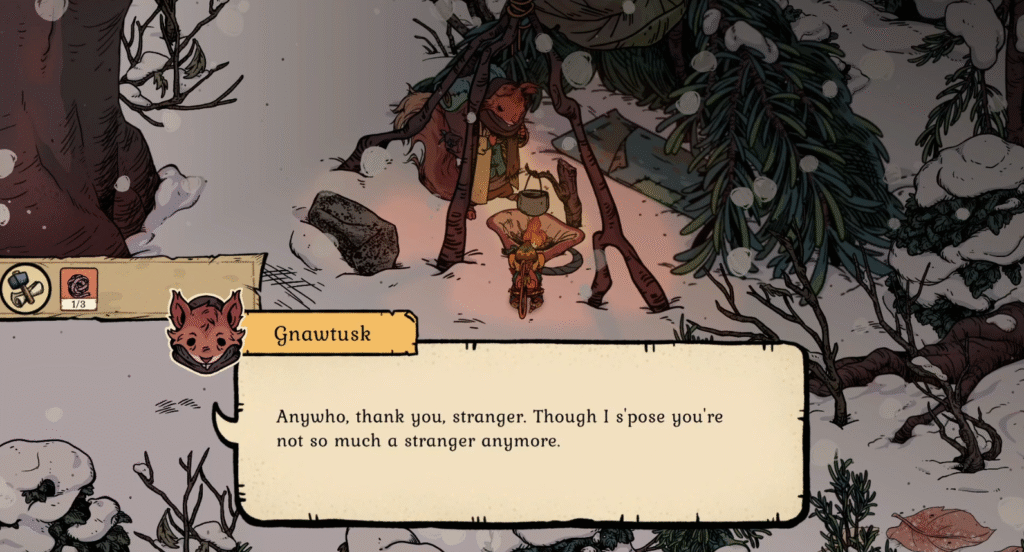
Nearly all quests are centred around finding certain items or resources for characters, often leading to being rewarded with blueprints for new furniture or better clothing and tools. Upgrading your clothes increases your cold resistance, while better tools allow you to collect more types of resources. Furniture is used purely cosmetically to decorate your burrow, with all container types you make having a shared inventory, and there being no difference between different types of the same object except visuals. This feels like a missed opportunity, as I felt little incentive to make any furniture other than a bed and some planters to grow herbs in. Again, I appreciate that it is more of a cosy element than a survival one, but it would have been nice if the cosiness of your burrow had some impact on the game. You can expand the burrow, giving you access to a floor upstairs as well as a basement where you can cultivate mushrooms, but that is the extent of the burrow’s growth. Ultimately, it is where you craft, cook, store things, and sleep.
There are a few types of insects you’ll find roaming the forest floor, and some of them will attack on sight. You fight them using your tools, and combat is very simplistic, with a standard sidestep and one-two combo repeated being all that is needed to outsmart the AI. By the final few hours of the game, I was just running by all of them, having stocked up on dozens of nut-based sweet treats that were easier to harvest, and able to outpace any attacker. It’s another example of the game’s attempt to have something that resembles danger but otherwise feels lacking, the same way that, instead of playing out the few high-energy moments in the story, they are told to you via still image cutscenes.

Ultimately, I do not believe that a cosy game has to be devoid of peril or pressures, and I feel that Winter Burrow may have benefited from dropping the survival elements and focusing more on a narrative-focused game with crafting and management elements, or adding more challenge to strengthen the survival elements through to the end of the game. This is a situation where I could see difficulty options being a huge benefit, allowing players to enjoy their preferred level of cosiness versus survival.
Visuals
The highlight of Winter Burrow is its hand-drawn art style, which looks like something out of an illustrated children’s book: clean, immersive, and full of exquisite details. Different regions of the forest are distinct the moment you enter them, from the dense Shadow Pines with their dark spots that you need a lantern to explore, to the wide open White Pillars with clearings surrounded by tall, thin trees. While I would find myself getting turned around navigating areas the first few times, it didn’t take me long to make a mental map of where all important locations and NPCs were, as well as where to find certain resources, thanks to the visual identity and design of each region.
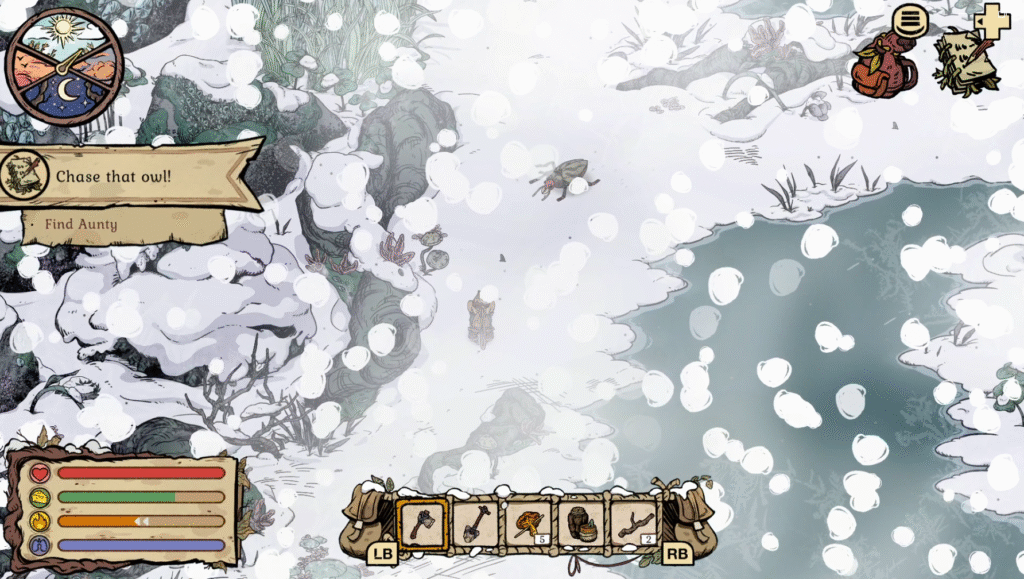
As I mentioned earlier, there is a great amount of detail throughout Winter Burrow’s visuals, from its lofty trees right down to a single blackberry or whisker, and it is all that detail that gives the game so much life. There is a balance between the quiet, still environments blanketed in white snow and the attention the developers have paid to make sure this small world doesn’t feel empty or boring. This is perfectly illustrated in the footprints that your mouse leaves behind: tiny dots that trail behind you as you press on through the cold. I say this because this little detail is utilised to enhance the gameplay, acting as a marker of where you have been and a link back to your burrow. That is, unless it snows, leading to your paw prints disappearing, leaving you in a sea of crisp white powder. It’s this union of visuals and gameplay where Winter Burrow is at its strongest, like the icy crystals that form around the edge of your screen as your heat depletes, a warning to seek out warmth or fall victim to the chill.
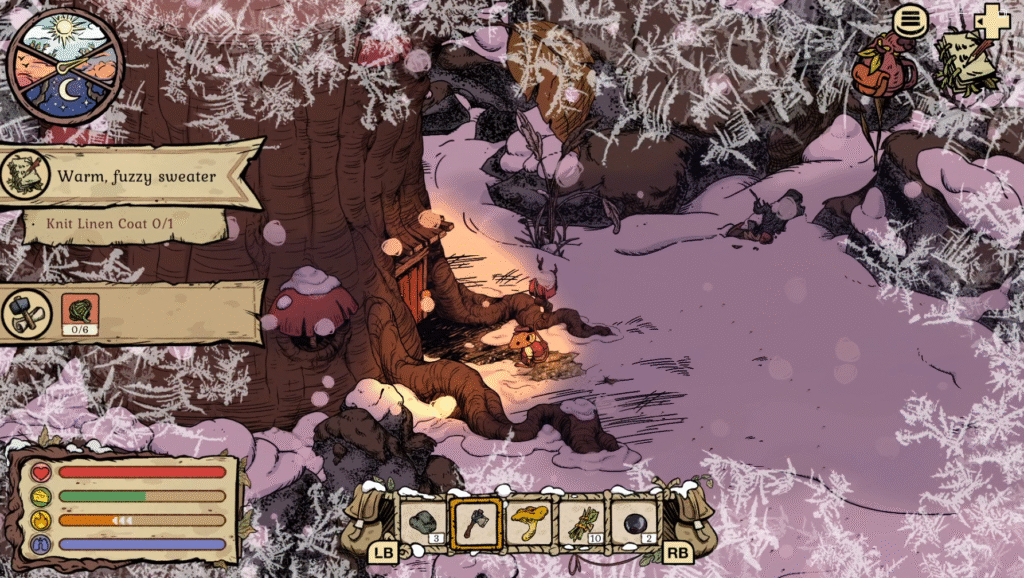
The game’s UI is easy to read and delivers all relevant information to you as needed, with the option to track one quest and have it appear on the left side of the screen. Menus are easy to navigate, but it would be nice to have some filtering options when looking through your stash, as everything you gather is held in one place. Animations in Winter Burrow have a cutout quality that adds to the game’s charm and clarity, while different types of weather, shadows, and time of day give it a natural, meditative quality.
Audio
Winter Burrow’s soundtrack is diverse, with each NPC having their own theme, along with combat and your burrow having their own as well. Each rendition sounds excellent and captures the atmosphere of that particular character or area beautifully, and on occasion foreshadows in a way that surprised and impressed me. My only gripe was that tracks seemed to move quickly between one another, often meaning that I would hear the first few notes of one track before another would quickly replace it.
There is no voice acting in the game, with characters communicating through text, accompanied by appropriate animal noises, which I found very endearing. This is doubly true for the player character, whose little squeaks, laboured breaths, and grunts of exertion brought a smile to my face. I think it was a good call not to have VA, as it doesn’t over anthropomorphise the animals and gives them a more grounded nature. It was my simple assumption that the animals understood each other, regardless of how they spoke, and that was enough for me to enjoy their interactions.

Conclusion
Winter Burrow is made up of many well-crafted parts that never quite knit together into something greater. Its charming world, heartfelt characters, and exquisite art direction create a warm, inviting atmosphere that’s easy to sink into — but its survival systems and narrative pacing rarely meet the same level of polish. For those seeking a gentle, low-stress adventure to unwind with, Winter Burrow will feel like a comforting cup of tea. For others hoping for a more engaging or cohesive experience, it might leave them out in the cold.

Winter Burrow is available on PC, Xbox One, Xbox Series, Nintendo Switch, and releases day one on Game Pass.
The game was reviewed on PC using a controller.
We would like to thank Pine Creek Games for providing us with a review code.
The Gamer Social Club runs a Monthly “Book Club” for gamers. Where we play games from our backlog or the latest Indie gem everyone is talking about. So, join The Gamer Social Club Discord to become involved in this month’s Game of the Month.
We also have several weekly shows on The Gamer Social Club Network YouTube channel to keep up to date with news, reviews, interviews, and all sorts of fun.
Winter Burrow Guides
- Winter Burrow 100% Achievement Guide
- Friends In A Nutshell Achievement Guide
- Moss Moves On Achievement Guide
- Family Reunion Achievement Guide
- Willow’s Epiphany Achievement Guide




